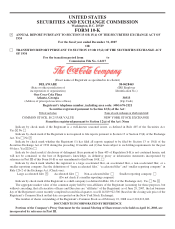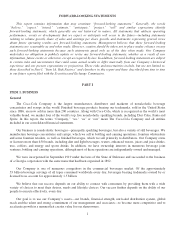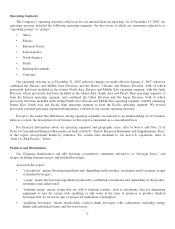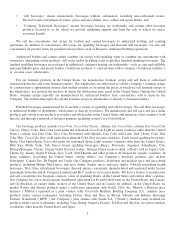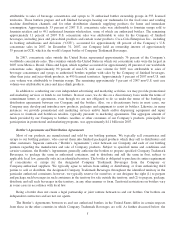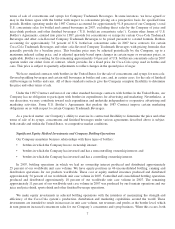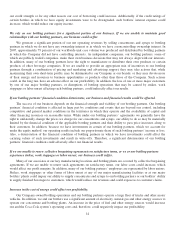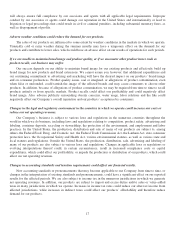Coca Cola 2007 Annual Report Download - page 11
Download and view the complete annual report
Please find page 11 of the 2007 Coca Cola annual report below. You can navigate through the pages in the report by either clicking on the pages listed below, or by using the keyword search tool below to find specific information within the annual report.Colombia; all of Costa Rica, Nicaragua, Panama and Venezuela; and greater Buenos Aires, Argentina. Coca-Cola
FEMSA estimates that the territories in which it markets beverage products contain approximately 48 percent of the
population of Mexico, 16 percent of the population of Brazil, 98 percent of the population of Colombia, 47 percent of
the population of Guatemala, 100 percent of the populations of Costa Rica, Nicaragua, Panama and Venezuela, and
31 percent of the population of Argentina. In 2007, Coca-Cola FEMSA’s net sales of beverage products were
approximately $6 billion. In 2007, approximately 63 percent of the unit case volume of Coca-Cola FEMSA consisted
of Coca-Cola Trademark Beverages, approximately 33 percent of its unit case volume consisted of other Company
Trademark Beverages and approximately 4 percent of its unit case volume consisted of beverage products of
Coca-Cola FEMSA or other companies.
Coca-Cola Amatil Limited (“Coca-Cola Amatil”). At December 31, 2007, our Company’s ownership interest in
Coca-Cola Amatil was approximately 30 percent. Coca-Cola Amatil has bottling and distribution rights, through direct
ownership or joint ventures, in Australia, New Zealand, Fiji, Papua New Guinea and Indonesia. Coca-Cola Amatil
estimates that the territories in which it markets beverage products contain 100 percent of the populations of Australia,
New Zealand, Fiji and Papua New Guinea, and 98 percent of the population of Indonesia. In 2007, Coca-Cola Amatil’s
net sales of beverage products from continuing operations were approximately $2.9 billion. In 2007, approximately
49 percent of the unit case volume of Coca-Cola Amatil consisted of Coca-Cola Trademark Beverages, approximately
38 percent of its unit case volume consisted of other Company Trademark Beverages and approximately 13 percent of
its unit case volume consisted of beverage products of Coca-Cola Amatil.
Other Interests. BPW, our joint venture with Nestlé, is focused on the total ready-to-drink tea category
worldwide, except in the United States and Japan. Multon, a Russian juice business operated as a joint venture with
Coca-Cola Hellenic, markets and sells juice products in Russia, Ukraine and Belarus. Jugos del Valle, a beverage
business we acquired jointly with Coca-Cola FEMSA in the fourth quarter of 2007, markets and sells packaged juices,
nectars and fruit-flavored beverages in Mexico and Brazil.
Seasonality
Sales of our ready-to-drink nonalcoholic beverages are somewhat seasonal, with the second and third calendar
quarters accounting for the highest sales volumes. The volume of sales in the beverages business may be affected by
weather conditions.
Competition
Our Company competes in the nonalcoholic beverages segment of the commercial beverages industry. Based on
internally available data and a variety of industry sources, we believe that in 2007, worldwide sales of Company
products accounted for approximately 10 percent of total worldwide sales of nonalcoholic beverage products. The
nonalcoholic beverages segment of the commercial beverages industry is highly competitive, consisting of numerous
firms. These include firms that, like our Company, compete in multiple geographic areas as well as firms that are
primarily regional or local in operation. Competitive products include numerous nonalcoholic sparkling beverages;
various water products, including packaged, flavored and enhanced waters; juices and nectars; fruit drinks and
dilutables (including syrups and powdered drinks); coffees and teas; energy and sports and other performance-
enhancing drinks; dairy-based drinks, and various other nonalcoholic beverages. These competitive beverages are sold
to consumers in both ready-to-drink and other than ready-to-drink form. In many of the countries in which we do
business, including the United States, PepsiCo, Inc. is one of our primary competitors. Other significant competitors
include, but are not limited to, Nestlé, Cadbury Schweppes plc, Groupe Danone, Kraft Foods Inc. and Unilever. We
also compete against numerous regional and local firms in various geographic areas in which we operate.
Competitive factors impacting our business include, but are not limited to, pricing, advertising, sales promotion
programs, product innovation, increased efficiency in production techniques, the introduction of new packaging, new
vending and dispensing equipment, and brand and trademark development and protection.
9

